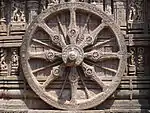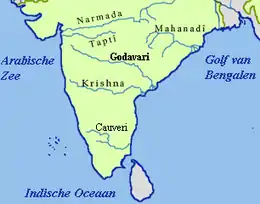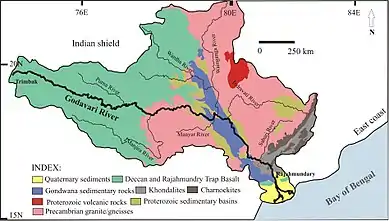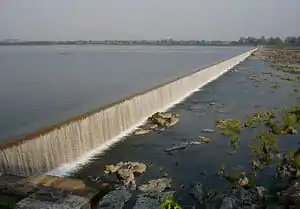Kalahandi district
Kalahandi (locally pronounced Kalahani) is a district of Odisha in India. The region had a glorious past and great civilisation in ancient time. Archaeological evidence of Stone Age and Iron Age human settlement has been recovered from the region.[2] Asurgarh offered an advanced, well civilised, cultured and urban human settlement about 2000 years ago in the region.[3] In South Asia it is believed that the lands of Kalahandi district and Koraput district were the ancient places where people started cultivation of paddy. In ancient time it was known as Mahakantara (meaning great forest) and Karunda Mandal, which means treasure of precious stones like karandam (corundum/manik), garnet (red stone), beruz, neelam (sapphire/blue stone), and alexandrite, etc. Manikeswari (the goddess of Manikya or Karandam) is the clan deity of Kalahandi may also signify its historical name.
Kalahandi district | |
|---|---|
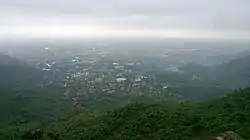 Hello Point | |
 Location in Odisha, India | |
| Coordinates: 20.083°N 83.2°E | |
| Country | |
| State | |
| Headquarters | Bhawanipatna |
| Government | |
| • Collector & District Magistrate | Parag Harshad Gavali, IAS |
| • Divisional Forest Officer Cum Wildlife Warden | Nitish Kumar, IFS |
| • Superintendent of Police | Dr. Saravana Vivek M, IPS |
| • MP of Kalahandi | Basanta Panda (BJP) |
| Area | |
| • Total | 7,920 km2 (3,060 sq mi) |
| Population (2011)[1] | |
| • Total | 1,576,869 |
| • Density | 169/km2 (440/sq mi) |
| Languages | |
| • Official | Odia, English |
| Time zone | UTC+5:30 (IST) |
| PIN | 766 001,766 002 |
| Vehicle registration | OD-08 |
| Sex ratio | 0.999 ♂/♀ |
| Literacy | 59.22% |
| Lok Sabha constituency | Kalahandi |
| Vidhan Sabha constituency | 5
|
| Climate | Aw (Köppen) |
| Website | www |
| This article is part of a series on |
| Odisha |
|---|
 |
| Governance |
|
| Topics |
|
Districts Divisions |
| GI Products |
|
|
It was a princely state in British India and in post independence period it merged with Odisha state in India as Kalahandi district comprising current Kalahandi district and Nuapada district. In 1967, Kashipur block from Kalahandi district was transferred to Rayagada district for administrative reason. Despite its backwardness it is one of the rich regions in history, agriculture, forest resources, gemstone, bauxite, folk dance, folk music, folklore, handicrafts and arts. In 1993, Nuapada sub-division was carved out as a separate district, but Kalahandi (Lok Sabha constituency) continues to constitute present Kalahandi district and Nuapada district together.
History
The archaeological record of 'Tel valley' reveals the presence of the primates in its zones during the Pleistocenephase. Paleolithic is being documented in Kalahandi, like Moter river basin in Dharamgarh region.[4] One of the largest size axe of late Stone Age culture has been recovered from Kalahandi.[5] Tel river civilisation put light towards a great civilisation existing in Kalahandi in the past that is recently getting explored.[6] The discovered archaeological wealth of Tel Valley suggest a well civilised, urbanised, cultured people inhabited on this land mass around 2000 years ago[3] and Asurgarh was its capital. Kalahandi along with Koraput and Bastar was part of Kantara referred in Ramayana and Mahabharata.[7] In the 4th century BC Kalahandi region was known as Indravana from where precious gem-stones and diamond were collected for the imperial Maurya treasury.[8] During the period of Maurya emperor Ashoka, Kalahandi along with Koraput and Bastar region was called Atavi Land.[9] This land was unconquered as per Ashokan record.[10] In the beginning of Christian era probably it was known as Mahavana.[11] In the 4th century AD Vyaghraraja was ruling over Mahakantara comprising Kalahandi, undivided Koraput and Bastar region.[12] Asurgarh was capital of Mahakantara.[13] After Vyaghraraja, the Nala kings like Bhavadatta Varman, Arthapati and Skanda Varman ruled over south part of this region up to about 500, the territory was known as Nalavadi-visaya[14] and rest of Mahakantara, lower part of Tel river valley was ruled by king Tastikara and his scions, the kingdom was known as Parvatad-waraka, whose headquarters was Talabhamraka near Belkhandi.[11] In the 6th century a new kingdom developed in the Kalahandi tract under King Tustikara, but very little is known about other kings of his family. Maraguda valley was identified as capital of Sarabapuriyas.[15] During Sarabapuriyas in the 6th century, Kalahandi lost its political entities and merged with eastern part of South Kosal or Kosal.[16] But this was also for a short period as in succeeding phase it assumed a distinct name Trikalinga. By the 9th–10th centuries the region including Western Odisha, Kalahandi, Koraput and Bastar was known as Trikalinga.[17] The Somavamsi king Mahabhavagupta I Janmejaya (925 – 960) assumed the title Trikalingadhipati.[18] Trikalinga was short lived and Chindakangas carved out a new kingdom called Chakrakota Mandala or Bramarakota Mandala,[19] which later one expanded to whole Kalahandi and Koraput.
The Naga dynasty started ruling Kalahandi in 1006. The Nagas of Kalahandi are the only dynasty in Odisha having a record of thousand years (1050–1948). During the 12th century Chkrakota Mandal was incorporated with the Ganga realm of Kalinga, and renamed "Kamala Mandala",[20] thus Kalahandi region became part of Kalinga as a feudatory of the Eastern Gangas under Nagas rules and continued till the 14th century. After 14th century Nagas owed allegiance from Eastern Gangas to the Suryavamsi Gajapatis. This territory assumed independence after the downfall of the Gajapatis of Odisha in 1568.
Vishwanath Dev Gajapati ruled over the feudatory of Kalahandi after the fall of the Gajapatis. Eventually, the Suryavanshi kings of Jeypore kept control of Kalahandi until 1712. Due to a family feud between two brothers King Ramachandra Dev I and his successor Balaram Dev III, the kingdom began losing control and saw its many feudatories claim independence from Jeypore. The royal house of Kalahandi joined hands with the Marathas and were later recognised as a Princely state in the Eastern States Agency. However, the two maintained cordial relations and according to one such account, Vikram Dev I was married to Lalitamani Devi of Kalahandi and was granted shelter by the house of Kalahandi during the invasion of Jeypore by the East India Company.[21]
According to tradition the Kalahandi kingdom commanded sovereign power over eighteen garbs. It was occupied by the Bhonslas of Nagpur in the middle of the 18th century but still it was a Gadajat under Nagas rule. In 1853 the Nagpur state lapsed to the British Crown as Raghujee III died without an heir. Then Kalahandi became a princely state under British and known as Karonda Mandal. Maharaja Pratap Keshari Deo, the Ex-Maharaja of Kalahandi, in one of his articles expressed his view that the historical significance of naming Kalahandi as Karunda Mandala is based on the availability of Corundum in this region. Manikeswari (the goddess of Manikya), the clan deity of the Naga kings of Kalahandi may have also necessitated the adoption of the name.
After Indian independence in 1947, Kalahandi joined India on 1 January 1948. On 1 November 1949, Patna Balangir district and Subarnapur district together constituted a separate district and the Nuapada sub-division of Sambalpur was added to the Kalahandi district. In 1967, Kashipur block of Kalahandi district was transferred to Rayagada division for administrative purpose. In 1993, Nuapada sub-division was carved out as a separate district, but Kalahandi (Lok Sabha constituency) continues to constitute present Kalahandi district and Nuapada district together.
Kalahandi Syndrome
Kalahandi hit the headlines in newspapers for the repeated drought situation that has broken the economic backbone of the cultivators. A long history of drought covering more than a century in Kalahandi has occurred. Drought had occurred in Kalahandi in 1868, 1884 and 1897. The famine of 1899 is otherwise known as "Chhapan Salar Durbhikshya". The effect of the famine, according to the District Gazetteers, were of a magnitude unprecedented in any previous famine. This famine left a terrible socio-economic gloom in this area. In 1919–1920 another drought occurred followed by cholera, influenza and malnutrition due to lack of foodstuff.
A series of droughts in 1922–1923, 1925–1926, 1929–1930, 1954–1955 and 1955–56 occurred in Kalahandi. The terrible drought of 1965–66, which occurred in Kalahandi, totally broke down the economic backbone of the people. Due to lack of rain, three-fourths of the crop production failed. The effect of the drought continued to be felt in 1967. As regards this drought, the following description from the District Gazetteers is worth quoting.
- "The bulk of the population which constituted the landless agricultural labourers became unemployed due to suspension of all sorts of agricultural operations. The worst sufferers were the landed gentry, who, because of the drought, could not reap a harvest nor could they take to manual labour to which they were not accustomed. The pastures lost the greenery and the bovine population therefore was equally starved. Everywhere there was an acute shortage of water."
Again in 1974–75 and in 1985 drought occurred like the Human Census occurring once in ten years. After the severe drought of 1956 and 1966, the rich cultivators of this area came down to the status of middle class cultivators and the middle class cultivators into ordinary ones. They all turned into Sukhbasis. The daily wage labourers and landless are generally called "Sukhbasi" in Kalahandi meaning those who live happily. A proverb for Sukhbasi runs thus: "Gai nai goru, sukhe nid karu" which means the men without cattle have happy sound sleep. Continuous occurrence of drought along with the irregular rainfall has resulted in crop failures and thus people became poorer to poorer. The state's Bureau of Statistics and Economics has analyzed the rainfall of South Western Kalahandi and has reported that "there is a year of drought in every three or four years". Along with the drought the problems such as rural unemployment, non-industrialization, growth of population and rapid deforestation are some of the major problems of Kalahandi. Hence being gripped both by nature and men, the rural inhabitant of Kalahandi has found no other way of survival. As a result, either he has migrated from his motherland or lived in the wasteland as a crippled soldier. Kalahandi has been in the news since the middle of the 1980s when India Today[22] reported sale of a child by its parents due to financial crisis. That article led the then prime minister Rajiv Gandhi to pay a visit to the district and brought the district to the attention of the national stage for its acute poverty and famine. Subsequently, similar reported cases of starvation deaths and sale of children have led to the announcement of a host of relief efforts and development projects. This backward phenomena despite richness of Kalahandi was called Kalahandi Syndrome by social workers.[23] Prime Minister P. V. Narasimha Rao announced the famous KBK project for backward undivided Kalahandi, Bolangir and Koraput districts in 1994. Nonetheless, Kalahandi has not been able to take off despite of hosts of programmes, largely because of lacuna at implementation stage. As the basic infrastructure is dismal state, the development progress is very slow.
Kalahandi is more often used a symbol of backwardness in popular media and among politicians or social workers. Use of Kalahandi in popular literature has been controversial. In a literary conference, "Rajya Sastriya Lekhaka Sammilani" in 1994 at Bhawanipatna, many invited speakers and local intellectuals pointed out that it's not wise to use the name "Kalahandi" as synonym for starvation death. Starvation death does not imply image of Kalahandi completely and by using it for starvation death other rich aspects of life in Kalahandi are being ignored. Starvation death was just one side of a coin, like poverty in Odisha or India. However, there are many writers, philosophers, social workers, journalists, politicians etc., particularly in India who are continue to use the name in literature, articles and reviews.
The Kalahandi film made by Indian film director Gautam Ghose received critical notice.[24] Rahul Gandhi's comparison of Purulia with Kalahandi had brought political controversy in West Bengal.[25]
Political marginalization in recent times
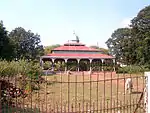
Politically, the district does not have much importance in state or national politics. Though in 2000 and 2004 elections Biju Janata Dal- Bharatiya Janata Party combined had won all the MLA and MP seats in Kalahandi, in 2009 election people opted for Indian National Congress except Dharamgarh MLA constituency, which is largely seen as ongoing political negligence to this region. Bhakta Charan Das, as third time Indian National Congress MP from the district did not received any Union Ministry in Manmohan Singh's Ministry. During the Chandrasekhar regime (1990–91), Bhakta Charan Das was part of the union ministry in the Railway and Sports department. No other MPs in last three decades have made it to any important post of national or state level. Pradeep Naik the seating MLA from Bhawanipatna Constituency is leader of opposition of Odisha assembly. Bhupinder Singh, Jagannath Pattnaik and Rasa Bihari Behera had been among the opposition leader, senior leaders, ministers in Odisha. Despite trio of them being in an important ministry like Revenue and Tourism, Agriculture they failed to make it to limelight. Earlier Pushpendra Singh Deo was a state and later on cabinet minister and currently Dibya Shankar Mishra is a state minister in Naveen Patnaik Government in Odisha since 2000. Political disappointment in the region is raising. Kalahandi highlighted for starvation and poverty is often marginalised in Odisha state and Indian national politics. This discrimination is thought to be due to national politics. Immediately after independence Kalahandi Lok Sabha Constituency was represented by non-congress candidate for 30 years, the period India was ruled by Congress Party. Thus, Kalahandi Lok Sabha Constituency was neglected and left out of development initiatives when the Congress ruled at the centre. Indira Gandhi visited Kalahandi in the early 1980s; Rajiv Gandhi visited in 1984; Sonia Gandhi visited in 2004, and Rahul Gandhi visited in 2008, 2009 and 2010. Since 1980, the Indian National Congress has been ruling for 20 years at the centre. Despite late prime ministers Indira Gandhi, Rajiv Gandhi, P.V. Narasimha Rao, and present leaders Atal Bihari Vajpayee, Sonia Gandhi, Rahul Gandhi etc. Tall claims for developing Kalahandi, little was done for long-term sustainable development in higher education, national highway, railway and industry during those leadership at Delhi. Few initiatives taken in post-independence of India for developing Kalahandi were only during non-congress rule in India such as Upper Indiravati Irrigation Project (during Moraji Desai as Prime Minister of India), Lanjigarh road – Jungarh and possibility of extending to Nabarangpur district (during Chandrasekhar as Prime Minister of India), National Highway 201 & 217 passing through Kalahandi (during Atal Bihari Vajpayee as Prime Minister of India), all these projects are not yet fully accomplished.
The Central government of India has established two public sector factories such as HAL factory and NALCO factory in the neighbouring Koraput district (part of KBK), a Lok Sabha constituency held by congress party since independence, and an ordnance factory in Balangir district (part of KBK) leaving only Kalahhani among KBK for such development in the region. No public sector industrial investment has been taken place in Kalahandi since past 62 years. Local need in major infrastructure in railway, highways and demand for a railway factory and Central University is not yet addressed. In 2008, "India Today" surevy put Kalahandi among the bottom five Lok Sabha Constituency in Socio-economic and infrastructure development in India.
Administrative Setup
Kalahandi has been divided into two sub-divisions namely Bhawanipatna subdivision and Dharamgarh subdivision and 13 blocks.
- Blocks under Bhawanipatna subdivision are: Bhawanipatna, Kesinga, Lanjigarh, Narla, Karlamunda, M. Rampur, and T. Rampur.
- Blocks under Dharamgarh Sub-Division are: Dharamgarh, Junagarh, Koksara, Jaipatna, Kalampur, and Golamunda.
Struggle for irrigation project
During princely state Kalahandi, a major irrigation project was initiated on Indravati River to build Indravati Dam by Maharaja Pratap Keshari Deo[26] around 1939–47, and along with engineer Bhubaneswar Behera and administrator Ram Chandra Patra he visualized and prepared the blue print. However, in 1948 princely state of Kalahandi was merged as part of Odisha state and this could not be materialized. In post independence period as member of parliament Pratap Keshari Deo fought from 1950 to 1979 but was not able succeed as he was in the opposition of congress party until new Govt. formed by late prime minister Maraji Desai in 1978, who accepted Deo's proposal to construct the Indravati dam for hydroelectricity generation and irrigation purposes. Many people think such delay was due to Congress Party which was ruling India since independence and was not in a favour of development of a Lok Sabha Constituency which was represented by non-congress party. After late prime minister Moraji Desai's approval and foundation stone in 1978, the project took more than two decades to be realised and was alleged with corruption.However, the project is a major boost to agricultural development today known as Upper Indravati Hydroelectric and irrigation project.[27] There are still concerns and lack for government funds to irrigate Koksara, Golamunda and Bhawanipatan blocks in Kalahandi through this projects as every year lots of water is released from the dam through Hati river without using for irrigation. Similarly water shades in Tel river for irrigation in Kalahandi is one of the basic demands of local farmers which is not getting Government support.
Struggle for a central university
Refer to video Part I,[28] II[29] and III[30] Kalahandi was struggling for a higher educational institution since independence. Earlier proposal to establish a Government Engineering College or a state University in Kalahandi or Koraput region in the 1980s was later on shifted to some other part in Odisha for political reasons. A team visited by planning commission to Kalahandi Balangir Koraput (KBK) region had suggested to establish an agriculture college in the region. Since 1988 people of Kalahandi are seriously demanding a Central University in Kalahandi as it is central to all KBK districts and has good railway connectivity to major cities in India from Kesinga railway station. In the 1990s when state Government of Odisha proposed to establish a University in northern Odisha, people of Kalahandi repeated their demand for such a University in Kalahandi as well. Then Chief Minister of Odisha Biju Patnaik while addressing publicly in Government College Bhawanipatna said Government could not establish University if people want to establish University in their neighbourhood. But Mr Giridhar Gomang, Chief Minister of Odisha later in 1999 agreed to establish two Universities in Baripada and Balasore due to public protest making people of Kalahandi highly disappointed. This otherwise unorganized and weak demand took serious turn when leading academician Prof. Gopa Bandhu Behera established "Kalahandi Sikhya Vikas Parishad'[31] in Bhawanipatna in 1999 through it and "Central University Kriya Committee" the struggle for a Central University in Kalahandi continued seriously. Many memoranda were submitted to both state and central Government in this regards since then. In the meantime, in 2006–07, non-resident Indians of Odisha origin and activists in Bhubaneswar started campaigning for central universities in every state and that of one in KBK districts of Odisha. Few NRI advocated for such higher educational institutions in Kalahandi.[32] When Government of India announced to establish 12 Central Universities in various states not having any Central University across India which included Odisha, a delegation from Kalahandi consisting intellectuals, general people and politicians met Odisha's Chief Minister Naveen Patnaik in May 2008 to establish the Central University in Kalahandi.[33] Mr. Naveen Patnaik promised and asked them to find out land details for establishing it in Kalahandi. People of Kalahandi sent the land details through district of Collector of Kalahandi in July 2008. However, without studying it, Odisha's Chief Minister unilaterally announced to establish proposed Central University of Odisha in Koraput,[34] though it was expected to come up in Bhawanipatna.[35] Again a team from Kalahandi visited Chief minister immediately after the announcement and Chief minister of Odisha promised visiting delegation of Kalahandi to establish a Government Engineering and Agriculture Colleges in Bhawanipatna.[36] People of Kalahandi though welcome establishment of such the colleges, Kalahandi Sikhya Vikas Parisad and Central University Kriya Committee said it's not a replacement for the Central University[37] as estimated cost for the proposed Central University is ₹8 billion (US$110 million) with an area of 500 acres (2.0 km2) of land, whereas both Engineering and Agriculture Colleges are estimated to be 100 million as per Government announcement so far. Subsequently, on 26 Dec 2008 leading academician from abroad demanded to covert Government Autonomous College Bhawanipatna to a University in the line of University tag given to Ravenshaw College, UCE Burla and Khallikote College.[38] Coincidentally next day on 27 Dec 2008 Odisha chief minister officially announced an Engineering College and an Agriculture College at Bhawanipatna keeping his earlier promise.[39] However, the demand to covert Government Autonomous College Bhawanipatna to a University was further taken by students, Kalahandi Sikhya Vikas Parisad, academicians, and local leaders for over a decade.[40] Finally, Odisha Government announced to convert Government Autonomous College Bhawanipatna to a University in Feb 2019, just before the assembly election.[41] Few NRI also had demanded to either establish a Central Agriculture University[42] or a state agriculture university in Kalahandi because of its agriculture potential and central location in the KBK region, subsequently then Union minister of Agriculture asked Odisha Govt. to study this referring to letter by Kalahandi MP[43] and before election of 2014 Odisha Govt. had included in its manifesto to establish second Agriculture University in an area under KBK districts.[44] Although academicians,[45] Kalahandi Sikhya Vikas Parishad[31] and people have been demanding to establish Agriculture University in Bhawanipatna, no progress has been made yet.
Struggle for a railway lines and rail factory
Kalahandi and Nuapada districts have a higher number of migrant workers than other states. Agriculture alone is not enough for employment generation for this region and needs industrial development. Since 2008, non-resident Indian of Kalahandi origin have initiated and appealed to establish a railway factory in the backward KBK region.[46] In the 2010-11 budget Indian railway has proposed a Wagon factory to be established in Bhubaneswar or Kalahandi.[47] But Odisha Government proposed to establish such Wagon factory in Ganjam district, which was highly criticized by intellectuals, non-resident Indians, local people and politicians. Protest continued in Kalahandi region by local leaders, people and NRI for two years. Due to public pressure in the 2013-2014 railway budget announcement was made for setting up a Wagon Periodical Overhauling Workshop in Kalahandi, and again this was shifted to Vishakapatnam (Vadlapudi) because of technical reason.[48][49] Moreover, in the 2017-18 union budget, an Electric Loco Periodical Overhauling Workshop was announced to be set up in Kalahandi with an investment of Rs 186 crore.[50] Not much progress has been made since then.
Lanjigarh–Junagarh section under East Coast Railway Zone was completed in March 2014, which was sanctioned when local MP Bhakta Charan Das was minister of state for railway in 1990–91. The surveyed railway line, Kantabanji (Balangir) -Jeypore (Koraput) via Nuapada, Kalahandi and Nabarangpur districts, needs approval, funding and immediate implementation.[46] Similarly Junagarh Road-Nabarangpur rail line project is pending for 8 years to get budgetary approval despite appeal from locals and academicians.[51] NRI of Odisha origin initiated demanding to survey for Raipur-Rajim-Gariabandh-Debhog-Dharamagrh-Junagarh since 2008,[52] Lanjigarh road-Phulbani-Angul (Talcher) since 2009[53] and Bhawanipatna-Kesinga since 2011,[54] and survey by Indian railway was approved for Talcher-Phulbani-Lanjigarh in 2010,[55] Raipur- Rajim-Gariabandh-Debhog-Dharamagrh-Junagarh in 2012,[56] Bhawanipatna-Kesinga in 2017[57] for but not much progress has been made for these projects.
Geography
Kalahandi lies in between 19.3 N and 21.5 N latitudes and 82.20 E and 83.47 E longitudes[58] and occupies the south western portion of Odisha, bordered to the north by the Balangir district and Nuapada district, to the south by the Nabarangpur district, Koraput district and Rayagada district, and to the east by the Rayagada district, Kandhamal district and Boudh district. It has an area of 8,364.89 square kilometres and ranks 7th in area among the 30 districts of Odisha. The district headquarters is at Bhawanipatna which stands almost in the central location of the district. Bhawanipatna and Dharamgarh are two sub-divisions of Kalahandi. Junagarh, Jaipatna, Kesinga, Lanjigarh and Mukhiguda are other major towns in Kalahandi. Tel is the main river of Kalahandi. Other notably rivers are Indravati, Udanti, Hati, Utei, Sagada, Rahul, Nagabali, Mudra, etc. The topography of Kalahandi consists of plain land, hills & mountains. Kalahandi is surrounded by hills. Its border with Nabarangpur, Koraput, Rayagada and Kandhamal districts are hilly and mountainous. The district is primarily agricultural, with over one third of the district area covered with dense jungle forest. Industry is very limited, but bauxite and graphite deposits can be commercially exploited.
Economy
In 2006 the Ministry of Panchayati Raj named Kalahandi one of the country's 250 most backward districts (out of a total of 640).[59] It is one of the 19 districts in Odisha currently receiving funds from the Backward Regions Grant Fund Programme (BRGF).[59]
Agriculture
Kalahandi is largely an agriculture based economy. During Bengal famine Kalahandi alone had sent 100,000 tons of rice. During the 1930s princely state of Kalahandi had proposed to build upper Indravati project but subsequent merger of princely state with India delayed the project . It got approved in 1978 and yet to be fully completed. In the meantime drought occurred in the 1960s and lately in the 1980s. In the 1980s Kalahandi become infamous for drought, child selling, malnutrition and starvation death and social worker referred it as 'Kalahandi Syndrome'.[23] Though KBK[60] project was announced in the 1990s by central Government specially for undivided Kalahandi, Balangir and Koraput districts primarily keeping poverty, backwardness and starvation death in mind, undivided Kalahandi district continued to remain politically ignored. Kalahandi is an example of disparity/contrasts that exist in many parts of the developing/underdeveloped world. On the one side, this district is famous for famine and starvation deaths: this is the same district that is rich with agriculture. Dharamgarh sub-division was historical known for rice production in Odisha. Since the 2000s the Indravati Water Project, second biggest in the state has changed the landscape of southern Kalahandi, leading to two crops in a year. Because of this, blocks like Kalampur, Jaipatna, Dharamgarh, Jungarh, Bhawanipatna etc. are witnessing rapid agricultural growth. This has boasted the highest number of rice mills in Kalahandi among districts in Odisha. The number of rice mills in the district was around 150 in the year 2004–05. More than 70% have been built in the five years after commissioning of the Indravati project.
Forest resources
Forest based products like Mahua, Kendu leaf, wood, timber and bamboos contribute local economy largely. Kalahandi supplied substantial raw materials to paper mills in neighbouring Rayagada and Jeypore.
Gem stone
Kalahandi was famous for gemstone (Karonda Mandal) in ancient times. Its rich gemstone deposit included cat's eye, sapphire, ruby, garnet, crystal, topaz, moonstone, diamond, tourmoline, acquamarine, beryle, alexandrite, etc. The distribution and occurrence of precious and semi-precious gemstones and other commercial commodities of the region have found place in the accounts of Panini (5th century BC), Kautilya (3rd century BC), Ptolemy (2nd century AD), Wuang Chuang (7th century AD) and Travenier (19th century AD). Until recently, Kalahandi, along with Balangir, supplied gem stones for handicraft work that can be found in Delhi Haat. Jiligndara, near Junagarh of Kalahandi, has one of the largest ruby deposits of Asia as per Geological Survey of India.[61]
Industry
Vedanta Alumina Limited (VAL),[62] a subsidiary of Sterlite Industries, a major aluminium processor has made major investments by establishing a 1 MTPA Alumina Refinery and 75 MW Captive Power Plant at Lanjigarh. Though this project has received criticism from environmentalists, especially from tribals of Niyamgiri; supporters of VAL claims it has brought significant changes in Socio-Economic scenario of Lanjigarh and Kalahandi. The Union Environment Ministry in August 2010, rejected earlier clearances granted to a joint venture led by the Vedanta Group company Sterlite Industries for mining bauxite from Niyamgiri hills[63] making the company to depend on bauxite from outside Odisha. The company's proposal for Expansion of the Refinery to 6 MTPA, which would have made it one of the largest refinery in the world, was halted by India's environment ministry.[64]
Transport
Air
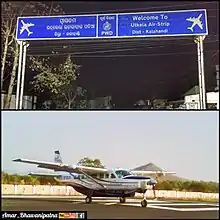
Utkela Airstrip (VEUK) is present near the city (22 km, 14 mi) which is scheduled to be operational with daily flights to state capital Bhubaneshwar and Raipur in the coming month of September by private air service provider Air Odisha under UDAN scheme by Ministry of Civil Aviation, Govt. of India.[65] Another one, Lanjigarh Airstrip (FR44733)(58 km, 36 mi) is private airstrip conducting VIP and chartered planes. Other nearby Airport are Swami Vivekananda Airport at Raipur, Chhattisgarh is 262 km (163 mi) away. Biju Patnaik International Airport in the state capital, Bhubaneswar is 427 km away by road and 631 km by rail.
Rail
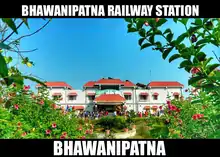
Bhawanipatna railway station was inaugurated on 12 August 2012.[66][67] It is situated on Lanjigarh-Junagarh rail line. Currently there are 3 trains (1 express and 2 passengers) running from Bhawanipatna to Bhubanneshwar, Raipur and Sambalpur.
Road
.jpg.webp)

Highways connecting Bhawanipatna to various cities:
- NH-26 - Bargarh - Bolangir - Bhawanipatna - Nabarangpur - Koraput - Vizianagram - Natavalsa
- SH-16 - Bhawanipatna - Khariar - Raipur
- SH-6 - Bhawanipatna - Chhatiguda - Ambodala - Muniguda
- SH-6A - M.Rampur - Narla - Chhatiguda
- SH-44 - Bhawanipatna - Gunupur - Thuamul Rampur - Kashipur - Tikri
Bhawanipatna Bus Stand is one of the biggest bus stand in Odisha present on NH-26. Both Private and Govt. buses are available from here. Bhawanipatna is one of the division of Odisha State Road Transport Corporation (O.S.R.T.C.) that runs Govt. Buses from Bhawanipatna to Bhubaneshwar, Vishakhapatnam, Sambalpur, Berhampur, Cuttack, Jeypore. Private Buses (A/C Sleeper Coaches) provide transportation facility to different cities in Odisha and Raipur, Durg etc. in Chhattisgarh. Newly added taxi facility and auto facility including Biju Gaon Gadi throughout Bhawanipatna and villages nearer to it, is adding an advantage to the transport facility.
 Hill Town Road (SH-44)
Hill Town Road (SH-44) Statue Square, Bhawanipatna
Statue Square, Bhawanipatna College Square, Bhawanipatna
College Square, Bhawanipatna Gandhi Park Road, BPT
Gandhi Park Road, BPT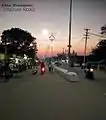 Stadium Road, BPT
Stadium Road, BPT
Demographics
| Year | Pop. | ±% p.a. |
|---|---|---|
| 1901 | 326,578 | — |
| 1911 | 393,006 | +1.87% |
| 1921 | 400,178 | +0.18% |
| 1931 | 476,407 | +1.76% |
| 1941 | 541,934 | +1.30% |
| 1951 | 585,825 | +0.78% |
| 1961 | 679,602 | +1.50% |
| 1971 | 824,975 | +1.96% |
| 1981 | 946,509 | +1.38% |
| 1991 | 1,130,903 | +1.80% |
| 2001 | 1,335,494 | +1.68% |
| 2011 | 1,576,869 | +1.68% |
| source:[68] | ||
According to the 2011 census Kalahandi district has a population of 1,576,869,[1] roughly equal to the nation of Gabon[69] or the US state of Idaho.[70] This gives it a ranking of 317th in India (out of a total of 640).[1] The district has a population density of 199 inhabitants per square kilometre (520/sq mi) .[1] Its population growth rate over the decade 2001–2011 was 17.79%.[1] Kalahandi has a sex ratio of 1003 females for every 1000 males,[1] and a literacy rate of 59.22%.[1]
Language and literature
Languages of Kalahandi district in 2011 census
At the time of the 2011 Census of India, 95.22% of the population in the district spoke Odia, 3.40% Kui and 0.85% Hindi as their first language.[71]
The language spoken by the people of Kalahandi is Kalahandia Language, locally known as Kalahandia. It is a dialect of Odia language. Local weekly newspaper such as "Didibi","Jagrata Hua"."Kalahandi Barta", "Masiha","Kalahandi Samachar","Andolan" andArjji and Kalahandi Express publish articles in standard Odia with Kalahandia Language dialect. Hindi is the second preferable language after Odia. Some of the known and recognised writers, poet and dramatists from the region are Chaitanya Das, Pataraja Padman Singh, Maharaja Udit Pratap, Maharani Asha Kumari Devi, Rama Chandra Raiguru, Brajaraj Singhdeo, Bira Bikram Deo, Lai Rudra Madhab Deo, Gadadhar Mishra, Parsuram Mund, Dr. Someswar Behera, Kaviraj Prayagdutta Joshi, Anup Singhde, Prof. Bhubaneswar Behera, Prafulla Kumar Rath, Gangadhar Hota, Bharat Bhusan Thakur, Uma Shankar Kar, Munir Biswabandhu, Lokanath Nayak, Sunil Chandra Nayak, Jayanta Kumar Behera, Sanjeeb Joshi, Lalit Kanungo, Akhila Nayak, Bharat Majhi, Parameswar Mund, Dr Dola Govinda Bisi, Dr Hare Krushna Meher, and others.
Other languages include Kui, Bhatri, Parji, Bhunjia, spoken by approximately 7000 Bhunjia Adivasis.[72]
Culture
Kalahandi is a rich land in culture and festivals.[73] Since it is a melting point of southern Odisha and Western Odisha with a substantial tribal population, those living in hills as well as plain land, their culture, tradition, languages and belief along with mainstream Hindu culture have made Kalahandi region rich with culture and festivals. The mixture of Aryan and tribal culture makes Kalahandi region rich in its culture and festivals. In pre-independence period Kalahandi was largely inspired to Saivaism, Vaishanivism and Shakti puja. Shakti Puja is largely accepted among tribal, perhaps due to which Kalahandi was well known for celebrating Shati Puja. However, affect induction of Kalahandi as part of Odisha state, dominance of coastal Oriya culture in the state is increasingly influencing the local culture. Celebration of Rathajatra and construction of Jaggannath temple in Kalahandi has been increasingly realised unlike in old days of Radha Krishna temple.
Local custom
The majority of the population are Hindu, a small minority being Christian, Muslim, Sikh, Buddhist and Jain. 28% of the population are tribal people which has the majority of the impact on the local customaries and influenced the dialect.
Art & craft
Literally 'Kalahandi' means 'pot of arts'. This name has been possibly derived from "Gudahandi Caves" containing pre-historic paintings in red and black colours. Kalahandi is a rich land in terms of art and craft. Stone from Kalahandi is well known to make jewellery. Habasipuri pattern is well established in handloom Saree. Wood craft from Khaipadar is famous for export and domestic market.
Dance & music
Kalahandi has the wide varieties of dance forms comprising tribal and non-tribal dance. Among the districts level in Odisha, it has the maximum dance form. Overall Kalahandi life is associated with music and dance. Some of the dance found in Kalahandi such as Dalkhai, Jaiphula, Rasarkeli, Sajani etc. have similarities with the dance form in Balangir, Sambalpur, etc. regions[74] whereas Sari song, Pholia song, song related to nature etc. has similarities with Koraput region. However, Boria song, Nialimali, Kalakolik etc. mostly found in Kalahandi. On the other hand, Ghumura, Madali, Dandari, Dhab, Bajasalia etc. folk form found in Kalahandi can be composed songs.
Ghumura dance is the most sought folk dance in Kalahandi. It is classified as folk dance as the dress code of Ghumura resembles more like a tribal dance, but recent researchers argue[75] different mudra and dance form present in Ghumura bear more resemblance with other classical dance form of India. The timeline of Ghumura dance is not clear. Many researchers claim[76] it was a war dance in ancient India and used by Ravana in Ramayana. Ghumura dance is depicted in Sun Temple of Konark confirming this dance form is since the medieval period. Ghumura dance has evolved from a war dance to a dance form for cultural and social activities. The dance is associated with social entertainment, relaxation, love, devotion and friendly brotherhood among all class, creed and religion in the present days. Traditionally this dance is also associated with Nuakhai and Dasahara celebration in Kalahandi and large parts of south western Odisha. Ghumura dance is still hidden in the village level in south western Odisha and some parts of bordering Andhra Pradesh and Chhattisgarh. Kalahandi region has taken a leading rule in popularising and retaining its unique identity of Ghumura dance. Ghumura dance has got the opportunity to represent the nation in international events Delhi, Moscow, and other places.
Popular Hindu festivals

- Dasra (Dasara): Dasara or Durga Puja is celebrated among Hindu all over India, but it is very popular in Eastern part of India including West Bengal, Odisha, Assam etc. However, goddess Durga is known as Shaki (Energy) and most of the goddess based on tribal and Shaki is inspired from goddess Durga. The major goddess of Kalahandi including Manikeswari, Lankeswari, Denteswari, Khameswari, Bhandargharen etc. are seen as a reflection of goddess Durga and most of the major festivals like Chhatar Jatra, Kkandabasha, Budharaja Jatra, etc. are celebrated during Dusra. Dusra is significant in all the Skati Pitha in Kalahandi and is one of the popular festival in the region.
- Diel or Deepawali: Also popularly known as Diwali is celebrated in Kalahandi. But this is getting popular due to immigrant business community mainly from Marwadi community, however, slowly it has entered the local stream.
- Rathajatra: The festival of Rathjatra is inspired from Rathajatra in Puri. Since independence when Kalahandi became part of Odisha state the dominance of coastal Oriya culture has influenced Kalahandi. Number of new Jagganath temples have come over Kalahandi since 1950 and celebration of Rathajatra is increasing realised. This is also boosted by immigrant business community and Government officials from coastal Odisha and Berhampur region.
- Shivaratri:
- Holi:
- Janmastami:
- Ramnabami:
Local specials
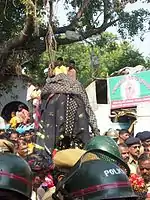
- Chhatar Jatra: The festival is celebrated in Bhawanipatna
- Khandabasa: The festival is celebrated in Junagarh in the Lankeswari Temple.
- Nuakhai: A local festival prevalent in Western Odisha. It is inspired from harvesting of new crops.
- Kalahandi Utsav:[77] Along with the district administration this festival is celebrated in Bhawanipatna and Dharamgarh.
Tourism around Bhawanipatna
- Maa Manikeshwari Mandir and Chatar jatra
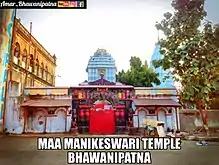 Maa Manikeswari Temple, Bhawanipatna
Maa Manikeswari Temple, Bhawanipatna
There are two Manikeshwari Mandir located in Kalahandi district of Odisha, one is in Bhawanipatna and other at Thuamal Rampur. The temple is located in the centre of Bhawanipatna. The main deity here is Goddess Manikeshwari. The main devotees are from the fishermen community. During Dussehra festival, animal sacrifice is offered at this temple which is a festival also known as Chatar jatra where lacs of people gather in the city to get the blessings from their beloved goddess . A film is also documented showing the ritual of animal sacrifice, before Goddess Manikeshwari.

Phurli Jharan is a tourist spot in Kalahandi. 15 km (9.3 mi) from Bhawanipatna, Phurlijharan is a perennial water fall about 30 ft (9 m) in height.
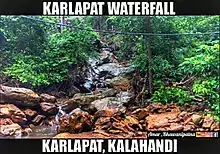
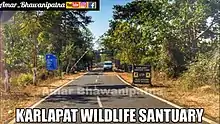
Present on SH-44 Karlapat Wildlife Sanctuary (Odia: କର୍ଲାପାଟ୍;Hindi: कर्लापाट्) is a wildlife sanctuary located in Kalahandi district and a tourist attraction of Odisha. Karlapat Wildlife Sanctuary is 12 km (7.5 mi) from Bhawanipatna, the district headquarters of Kalahandi district.
The sanctuary covers an area of 255 km2 (98 sq mi). It lies within the Eastern Highlands moist deciduous forests ecoregion. Major plant communities include mixed deciduous forests and scrublands. It has also high mineral deposit like bauxite and manganese etc.
This sanctuary is home to many wildlife species like tiger, leopard, gaur, sambar, nilgai, barking deer, mouse deer, a variety of birds and reptiles.
- Jakham
Jakham is a tourist destination on SH-44 (20 km away).

- Rabandara

Rabandara is a tourist spot near Bhawanipatna. 15 kilometres (9.3 mi) from city, Rabandara is a perennial water fall about 13 ft (4 m) in height.
- Sospadar Waterfall
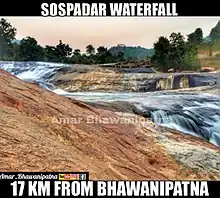
Sospadar is a location for picnickers and adventurers is yet to be placed on tourist map of Odisha (although many other places from Kalahandi are pending in their list) It is situated about 17 km towards east from Bhawanipatna under Gunduri panchayat via Icchapur, (Lanjigarh block).
- Gadagada Twin-Waterfall
- Zilla Sangrahalaya
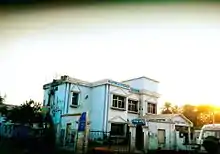
Zilla Sangrahalaya or the District Museum, Bhawanipatna has different artifacts, manuscripts, paintings and many rare items from pre-historic age (Asurgarh coins, Gudahandi paintings etc.) depicting ancient history of Kalahandi Redition. Place: Near New Bus Stand, NH-26, Bhawanipatna.
- Permunji
.jpg.webp)
Permunji is a nursery situated at the foot of great mountain, a place for picnics. Elephants are commonly seen near the nursery crossing roads.
- Hello Point
Hello Point is a picnic spot and valley view point 75 km (47 mi) from Bhawanipatna. It is present on the top of the Eastern Ghats from where half of the Kalahandi district is visible including Junagarh, Kalampur block etc. One can receive signal from all telecom services for mobile, therefore it is named as Hello Point.
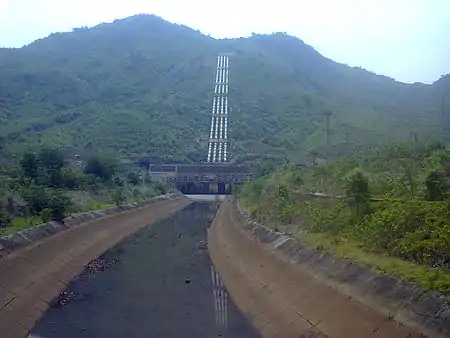
Indravati Dam or Upper Indravati Hydro Power Project is one of the largest Dam in India as well as Asia. It is the largest dam in eastern India which produces 600MW of electricity. The Upper Indravati Project envisages diversion of water, of the indravati river in its upper reaches into the Mahanadi valley for power generation and irrigation.
The project involves construction of 4 dams across the Indravati and its tributaries 8 dykes and two inter-linking channels to form a single reservoir with a live capacity of 1,435.5 million m3 (50.69 billion cu ft), 4.32 km (2.68 mi). tunnel, a power house with installation of 4 units of 150 MW each turbines, 9 km (5.6 mi) tail race channel and an irrigation barrage across Hati river with the associated irrigation canals i.e., Left Canal and Right Canal.
Irrigation from left canal is done in Kalampur, Koksara, Junagarh and Dharmagarh Block where Asia's longest aqueduct is made on Tel River near Odisha border. And right canal is done is Junagarh (Nandol area) and Bhawanipatna Block, the construction work is under process in Karlapada block where it merges with Ret River. The water comes from mainly Indravati River, Pet fula Naal etc.
 Phurlijharan Entrance
Phurlijharan Entrance Kalahandi Palace, Bhawanipatna
Kalahandi Palace, Bhawanipatna Baringdoro Waterfall
Baringdoro Waterfall Sabha Mandap, Raj Mahal Kalahandi
Sabha Mandap, Raj Mahal Kalahandi Inside Karlapat Wildlife Sanctuary
Inside Karlapat Wildlife Sanctuary Bhatang Padar Dam Reservoir
Bhatang Padar Dam Reservoir SH-44 Jakham Road
SH-44 Jakham Road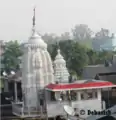 Lakshmi Mandir, Bhawanipatna
Lakshmi Mandir, Bhawanipatna Statue Square (1950s)
Statue Square (1950s) Grand view of Kalahandi Palace
Grand view of Kalahandi Palace Bhawanipatna Aerial View
Bhawanipatna Aerial View
Around Dharamgarh
- Junagarh: Lankeshwari temple, Dadhibamana temple, Kanak durga temple, Khandabasha, historical site
- Mukhiguda: Asias 2nd largest Power project, Indravati dam
- Dharamgarh: Paradeswar temple, Bhimkhoj, Nagbom, Kalahandi Utsav, Chaitra
- Ampani: Budharaja Temple and waterfall
- Gudahandi: Historial site[78]
- Dokrichanchra: Waterfall
- Chura Dangar: Hiking area and waterfalls
- Khairpadar: Village of handicraft
- Sri Aurobindo Relics Center, Dharamgarh- The sacred relics of Mahayogi Sri Aurobindo and The Mother was installed here.
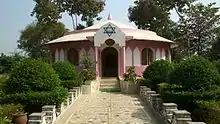
- Koksara
- Golamunda
- Goudchhendia
Notable people
- Bhubaneswar Behera: Engineer, academic, administrator and author.[79]
- Pratap Keshari Deo: Ruler, politician, social worker, archeologist and first visualized and took the initiative in the Indravati project.[80]
- Ram Chandra Patra, IAS (retd.): (1919-2013) Bureaucrat, social worker and administrator who took the initiative in the Indravati project.[81][82]
- Kishen Pattnaik: Socialist leader.[83][84] born 1930 in Kalahandi. Became National president of Samajwadi Yuvjan Sabha and was elected to Lok Sabha from Sambalpur aged 32
Education
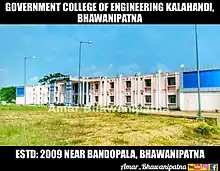

.jpg.webp)
Through the Western Odisha Development Council, the state government has been initiated a private medical college with a tie up with one South India based organisation in Junagarh block of Kalahandi since 2004, admissions took place in 2013 September later which was closed in 2015 due to inefficiency of proper management. Odisha state Government has announced Government College of Engineering Kalahandi and Agriculture College at Bhawanipatna in 2009 but local demand for a Central University in Kalahandi has not been accomplished. Another Medical College is being proposed State Government by support from Vedanta Alumina Company, Lanjigarh around 100 crores will be given by this private company by some exchange of allotment for Bauxite Mines to that Company by the State. This Medical College was proposed due to a long-standing agitation by the Students' of Sardar Raja Medical College & Hospital led by M Sameer Krishna Reddy and Local People led by Shri Dr A K Nanda, eminent Botany Scholar and politicians Shri Pradipta Naik, Shri Himansu Meher, Shri Bhakta Charan Das, Dharmendra Pradhan, Vasant Panda, Manmohan Samal and K V Singhdeo.
Technical Colleges
- Kalahandi Medical College, Bhawanipatna (proposed)
- Government College of Engineering, Kalahandi Bhawanipatna
- Government Agriculture College, Bhawanipatna
- Government Medical College, Bhangabari, Bhawanipatna
- Sardar Rajas Medical College & Research Centre, Jaring( Closed)
- Government Polytechnic College Bhawanipatna
Non-technical Colleges
- Government Autonomous College, Bhawanipatna
- Government Women's College Bhawanipatna
- Pragati Degree College, Bhawanipatna
- Saraswati Degree College, Bhawanipatna
- Sastriji Science College, Bhawanipatna
- Binayak Residential college, Bhawanipatna
- Jayaprakash Sandhya Mahavidyalaya, Bhawanipatna
- Agriculture College near Dharamgarh, proposed (private) by Sri Sri Ravishankar[85]
Hospitals
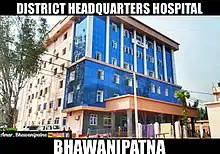
- District Headquarters Hospital, Bhawanipatna
- Maa Manikeswari Multi-speciality Hospital, Bhawanipatna
- Kesinga Hospital
- Sub-Divisional Hospital, Dharamgarh
Media

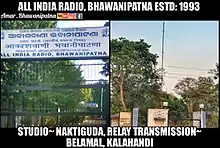
- Doordarshan Kendra (DD-6)
It was started as Low Power Transmission on 15 February 1987 and it had been upgraded to High Power Transmission on 20 January 1992. This 10 KW capacity Doordarshan kendra started functioning in 1992 is one of the few HPT centres among Sambalpur, Cuttack in Odisha. Program generating facility (studio) was started on 3 September 2002. Its one of the three Doordarshan Kendras in the state of Odisha other being Sambalpur and Bhubaneshwar. Its studio became operational in 2002. In 2004, it started broadcasting agriculturerelated programmes sponsored by Ministry of Agriculture and simultaneously began broadcasting agriculture programmes in different HPT (high power transmission) centres of KBK region.
Besides this, it also used to produce programmes to promote tribal heritage, culture, drama besides entertainment and awarenessbuilding programmes for the KBK. It was broadcasting agriculture related programmes from 6 pm to 6.30 pm on every Tuesday, Wednesday and Friday and local culture and entertainment based programmes from 5.30 pm to 6 pm each Monday and Thursday. During the period from 2005 to 2009, the centre has bagged 10 national awards and five nominee prizes for different programmes produced by it.
- All India Radio (Akashwani Bhawanipatna 103 FM)
All India Radio or Akashwani Bhawanipatna started on 30 December 1993 near Naktiguda, outskirt of the city. It has two transmitters 2x100 KW, MW in Belamal near Pastikudi. Frequency of Transmission is 1206 kHz, 248 MTs. It has two studios. Sanctioned strength of Radio station in all cadre is 100. No. Of Casual Announcers in the kendra is 56. Composition of originated programmes targets audience programme for Rural, Women Children, Youth & Senior Citizen, Light & Classical Music, Film Music. Broadcasting of programmes are done in Odia, Hindi, and English languages. The broadcasting covers a popuplation of approx. 18,66,000 Lacs from Kalahandi, Nuapada and nearby districts. All India Radio, #Bhawanipatna was started on 30 Dec 1993 at Naktiguda, Bhawanipatna i.e., Transmission and Studio and Radio Station at Belamal is a Relay Tower. Recently FM services have been started at AIR station at frequency of 103 MHz
Primary service zone, Kalahandi District and Naupada District. The station has not only popular in its primary zone, rather its audience from the district of Bolangir, Sonepur, Phulbani, Bargarh, Nawrangpur and Rayagara of Odisha and Raigarh district of Chhattisgarh. Moreover, this station serves the districts coming under the capital KBK scheme of the Govt. of India.
Transmission Strength~BEL HMB 140- 2 x 100 KW Frequency of Broadcast~1206 kHz and 248 mtrs. Mast Height~ 122 Meters.
- Amar Bhawanipatna (Tourism and Local Information Service Provider)
- The Abhyutthanam (Monthly Oriya news magazine)
- Kalahandi TV (Kalahandi District based web channel)
Establishment
- Upper Indravati Hydro-electricity Project, Mukhiguda
- Vedanta Alumina Refinery, Lanjigarh (private)
Politics
Vidhan sabha constituencies
The following is a list of the 5 Vidhan sabha constituencies[86][87] of Kalahandi district and the elected members[88] of that area
| No. | Constituency | Reservation | Extent of the Assembly Constituency (Blocks) | Member of 15th Assembly | Party |
|---|---|---|---|---|---|
| 77 | Lanjigarh | ST | Lanjigarh, Thuamul Rampur, Jaipatana (part), , Bhawanipatna (part) | Balabhadra Majhi | BJD |
| 78 | Junagarh | None | Junagarh (NAC), Junagarh, Golamunda | Dibyashankar Mishra | BJD |
| 79 | Dharmagarh | None | Dharmagarh, Koksara, Kalampur, Jaipatana (part) | Mousadhi Bag | BJD |
| 80 | Bhawanipatna | SC | Bhawanipatna (M), Kesinga (NAC), Bhawanipatna (PART), Kesinga (part) | Pradipta Kumar Naik | BJP |
| 81 | Narla | None | Madanpur-Rampur, Narla, Karlamunda, Kesinga (part) | Dhaneswar Majhi | BJD |
References
- "District Census 2011". Census2011.co.in. 2011. Retrieved 30 September 2011.
- B.Mishra, J. Bengal Art, Vol.9&10, 2004–2005, 383–410
- P.Mohanty, B. Mishra, Op. Cit,2000; C.R. Mishra, S. Pradhan, op. cit. 1989–1990, Infra, F.N.79
- R.P. Prusty, 1992, Paleolithic Vestiges from Kalahandi, Odisha Historical Research Journal, XXXVII, no.1-5, pp.55–66, Orissa State Museum, Bhubaneswar
- P. Mohanty, B. Mishra, Op. Cit,2001, p.47
- "A tale of Tel valley civilization uncovered". The New Indian Express. Retrieved 21 October 2010.
- Mahabharata Sabhaparva, 31, sloka-11-16
- Proceedings, Indian History Congress, 1947, 10th session, 178
- H. C. Rayachoudhury, Political History of Ancient India, 538
- B. Mishra, op.cit., 2003–2004
- N. K. Sahu, 1964, op. cit.
- N. K. Sahu, op.cit., 1964, p.200
- ibid.7
- N. K. Sahu, Utkal University, History of Orissa, 433
- S.P.Tiwari, Comprehensive History of Orissa, 95–96
- J. P. Singh Deo, op.cit.
- M.N.Das(Ed)Sidelight on History and Culture of Orissa, 36
- Orissa District Gazetteers, Kalahandi, 46–49
- ibid.47
- ibid.41
- Dutt 2015, p. 45.
- http://indiatoday.intoday.in/site/
- "The Kalahandi Syndrome: Starvation in Spite of Plenty Devinder Sharma* 19 April 2002". Mindfully.org. Archived from the original on 20 April 2013. Retrieved 22 May 2013.
- "Hunger Pangs Through A Lens Eye". The Financial Express. 19 January 2003. Retrieved 22 May 2013.
- "I saw Kalahandi in Bengal: Rahul Gandhi". India Today. 25 April 2009. Retrieved 22 May 2013.
- "Latest Releases". pibarchive.nic.in. Retrieved 12 May 2020.
- "Odisha Hydro Power Corporation Ltd". ohpcltd.com. Retrieved 12 May 2020.
- "Central University in Kalahandi Part1". 18 October 2011. Retrieved 22 May 2013 – via YouTube.
- "Central University in Kalahandi Part2". 18 October 2011. Retrieved 22 May 2013 – via YouTube.
- "Central University in Kalahandi Part3". Retrieved 22 May 2013 – via YouTube.
- "Kalahandi Sikhya Vikas Parishad". Business Standard. 1 February 2015.
- "The Pioneer, Bhubaneswar Edition". 9 February 2007.
- The New Indian Express, Bhubaneswar Edition, 8 May 2008
- The Statesman, Bhubaneswar Edition, 11 August 2008
- "The Pioneer". Pioneer. 1 January 1970. Retrieved 22 May 2013.
- The Telegraph (Kolkata), 29 December 2008
- The New Indian Express, Bhubaneswar Edition, 28 December 2008
- "NROs demand more Unitary varsity". Kalahandia. 26 December 2008. Retrieved 4 May 2020.
- Tathya.in 27 Dec 2008, Tathya.in 27 Dec 2008 (28 December 2008). "Double bonaza for Kalahandi". Kalahandia. Retrieved 4 May 2020.
- "Students seek varsity tag for Bhawanipatna college". The Times of India. Retrieved 4 May 2020.
- "CM announces B'patna College as university". The Pioneer. 17 February 2019. Retrieved 4 May 2020.
- Letter to Rahul Gandhi, Letter to Rahul Gandhi. "Copy of Letter".
- Times of India 5 Nov 2013, Times of India 5 Nov 2013. "Times of India Nov 5, 2013".
- Economic Times, Aug 2014, Economic Times, Aug 2014. "Economic Times, Aug 2014".
- Odisha.plus 2019, Odisha.plus 2019. "Odisha.plus 2019".
- "NROs urge Rahul Gandhi not to play politics with KBK". Kalahandia. 6 May 2008. Retrieved 4 May 2020.
- "RITES, SAIL to sign pact on wagon manufacturing unit". The Financial Express. Retrieved 22 May 2013.
- Delhi, Business Standard India, 22 March 2016 (22 March 2016). "Clarification regarding shifting of Wagon POH workshop from Kalahandi, Odisha to Vishakapatnam (Vadlapudi), Andhra Pradesh". Business Standard. Retrieved 4 May 2020.
- "Wagon POH Workshop relocated to Vishakapatnam after feasibility study: Railways – RailNews Media India Ltd". Indian Railway. Retrieved 4 May 2020.
- "2 new Railways industrial projects to come up in Odisha – RailNews Media India Ltd". Indian Railway. Retrieved 4 May 2020.
- Pioneer, The. "'Speed up Junagarh Rd-N'rangpur rly line works'". The Pioneer. Retrieved 4 May 2020.
- Tathya.in, Rail connectivity in KBK. "Tathya.in July 8, 2008".
- "Merinews Feb 1, 2009".
- The Pioneer 24 Nov 2011, Tathya.in 13 Nov 2011. "The Pioneer, Bhubaneswar Edition, Nov 24, 2011".
- "Indian Railway Budget 2010-11" (PDF).
- Govt of India, Rai budget. "Railway Budget 2012-2013" (PDF).
- "East Coast Railway India" (PDF). East Coast Railway India.
- Orissa District Gazetteers, Kalahandi, 2
- Ministry of Panchayati Raj (8 September 2009). "A Note on the Backward Regions Grant Fund Programme" (PDF). National Institute of Rural Development. Archived from the original (PDF) on 5 April 2012. Retrieved 27 September 2011.
- "Special Area Development Project For K.B.K Districts of Odisha". Kbk.nic.in. Retrieved 22 May 2013.
- P.Mohanty, B.Mishra, Environment and stone age culture of Kalahandi, Orissa in Peoples and Environment in India, edited by K.K.Mishra, M.L.K.Murty, p.42
- "Vedanta Aluminium, Odisha, India, Smelter, Captive Power Plant (CPP), Mining, Corporate Social Responsibility (CSR), Kalahandi, Niyamgiri, Jharsuguda, Aluminium Company". Vedantaaluminium.com. 15 July 2012. Retrieved 22 May 2013.
- "'Avatar' tribe defeats Vedanta : North, News". India Today. 25 August 2010. Retrieved 22 May 2013.
- "Government halts construction work at Vedanta refinery". Hindustan Times. 21 October 2010. Retrieved 22 May 2013.
- "Regional connectivity gets wings; five airlines get to fly 128 routes".
- "Bhawanipatna railway station opens". The New Indian Express. Retrieved 22 May 2013.
- "East Coast Railway". Eastcoastrail.indianrailways.gov.in. 12 August 2012. Retrieved 22 May 2013.
- Decadal Variation In Population Since 1901
- US Directorate of Intelligence. "Country Comparison:Population". Retrieved 1 October 2011.
Gabon 1,576,665
- "2010 Resident Population Data". U.S. Census Bureau. Archived from the original on 9 August 2011. Retrieved 30 September 2011.
Idaho 1,567,582
- 2011 Census of India, Population By Mother Tongue
- M. Paul Lewis, ed. (2009). "Bhunjia: A language of India". Ethnologue: Languages of the World (16th ed.). Dallas, Texas: SIL International. Retrieved 30 September 2011.
- Kalahandi: Loka Anusthan, edited by Jayanta Kumar Behera, Dr Dolagobinda Bisi, Parameswar Mund, Mahabir Sanskrutika Anusthan, 1998
- C. Pasayat, (Ed.) (2008), Paschima Odisara Lokageeta (in Oriya), Bhubaneswar: Folklore Foundation
- Loka Nutrya Ghumura, edited by Parameswar Mund, Mahabir Sanskrutika Anusthan, June 2002
- The Heroic Dance Ghumura, Edited by Sanjay Kumar, Mahabir Sanskrutika, 2002
- "Down for Maintenance". Archived from the original on 20 August 2014. Retrieved 2 November 2010.
- "Places of interest in the district".
- Sambit Misra (25 April 2001). "Professor Bhubaneswar Behera". Odiya.org. Archived from the original on 24 September 2015. Retrieved 22 May 2013.
- "Members Bioprofile". loksabhaph.nic.in. Retrieved 12 May 2020.
- Samabad, 2000
- Keun Mahatabanak Pain, Gana nath Das, The Prajatantra, 2 January 1988
- "Obituary". Cpiml.org. 8 October 2004. Archived from the original on 25 May 2013. Retrieved 22 May 2013.
- "Socialist leader Kishan Patnaik dead". Deccan Herald. 27 September 2004. Archived from the original on 25 September 2015. Retrieved 22 May 2013.
- "India is caught between scams and slums: Sri Sri Ravi Shankar". The Indian Express. 17 December 2010. Retrieved 22 May 2013.
- Assembly Constituencies and their EXtent
- Seats of Odisha
- "List of Member in Fifteenth Assembly". ws.ori.nic.in. Archived from the original on 2 May 2007. Retrieved 19 February 2013.
MEMBER NAME
- Dutt, Tara (2015), Odisha District Gazetteers: Nabarangapur (PDF), Government of Odisha, ISBN 978-81-86772-17-1
External links
| Wikimedia Commons has media related to Kalahandi district. |
- Official website
- Kalahandi Info
- Map of Kalahandi
- Map of Kalahandi
- Antodaya Kalahandi
- Indravati Project
- Sahabhagi Vikash Abhiyan
- www.abhyutthanam.com
- www.dkyo.org

